
Derived from the Greek word for '5', and "domino", a pentomino is a polyomino of order 5, that is, a polygon in the plane made of 5 equal-sized squares connected edge-to-edge. When rotations and reflections are not considered to be distinct shapes, there are 12 different free pentominoes. When reflections are considered distinct, there are 18 one-sided pentominoes. When rotations are also considered distinct, there are 63 fixed pentominoes.

Puzzle video games make up a broad genre of video games that emphasize puzzle solving. The types of puzzles can test problem-solving skills, including logic, pattern recognition, sequence solving, spatial recognition, and word completion.
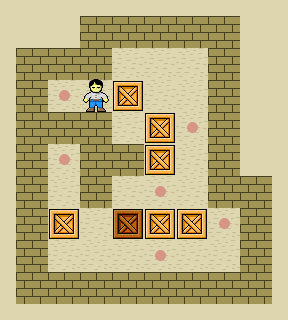
Sokoban is a puzzle video game genre in which the player pushes crates or boxes around in a warehouse, trying to get them to storage locations. The game was designed in 1981 by Hiroyuki Imabayashi, and first published in December 1982.

A crossword is a word puzzle that usually takes the form of a square or a rectangular grid of white- and black-shaded squares. The goal is to fill the white squares with letters, forming words or phrases, by solving clues, which lead to the answers. In languages that are written left-to-right, the answer words and phrases are placed in the grid from left to right ("across") and from top to bottom ("down"). The shaded squares are used to separate the words or phrases.
A puzzle is a game, problem, or toy that tests a person's ingenuity or knowledge. In a puzzle, the solver is expected to put pieces together in a logical way, in order to arrive at the correct or fun solution of the puzzle. There are different genres of puzzles, such as crossword puzzles, word-search puzzles, number puzzles, relational puzzles, and logic puzzles. The academic study of puzzles is called enigmatology.
A logic puzzle is a puzzle deriving from the mathematical field of deduction.

Nonograms, also known as Hanjie, Paint by Numbers, Picross, Griddlers, and Pic-a-Pix, and by various other names, are picture logic puzzles in which cells in a grid must be colored or left blank according to numbers at the side of the grid to reveal a hidden pixel art-like picture. In this puzzle type, the numbers are a form of discrete tomography that measures how many unbroken lines of filled-in squares there are in any given row or column. For example, a clue of "4 8 3" would mean there are sets of four, eight, and three filled squares, in that order, with at least one blank square between successive sets.
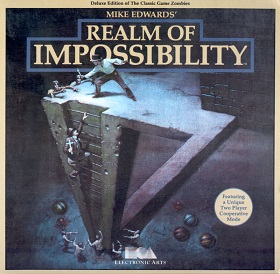
Realm of Impossibility is an action game created by Mike Edwards for the Atari 8-bit family and published by Electronic Arts in 1984. It was originally released in 1983 as Zombies and published by BRAM, a company formed by Edwards and a friend. BRAM previously developed and published Attack at EP-CYG-4.

Sudoku is a logic-based, combinatorial number-placement puzzle. In classic Sudoku, the objective is to fill a 9 × 9 grid with digits so that each column, each row, and each of the nine 3 × 3 subgrids that compose the grid contain all of the digits from 1 to 9. The puzzle setter provides a partially completed grid, which for a well-posed puzzle has a single solution.

Paganitzu is a puzzle video game created by Keith Schuler and published by Apogee Software for IBM PC compatibles in 1991. It is the sequel to Chagunitzu. The player controls Alabama "Al" Smith, who works his way through an ancient Aztec pyramid while solving Sokoban-like puzzles.

Egypt is a puzzle video game released for the Family Computer in 1991 by Human. It was released only in Japan. It is an object elimination type puzzle game. A player controls a spherical jewel and jumps from tile to tile. Stepping on an arrow shifts a row or column in the direction of the arrow. Placing two or more of the same object next to each other will erase them from the board, and this must be repeated until all the objects have been eliminated from the board.

Castle of Dr. Brain is an educational video game released in 1991 by Sierra On-Line. It is a puzzle adventure game.
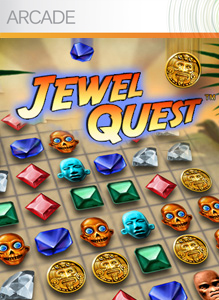
Jewel Quest is a tile-matching puzzle video game created and published by iWin. First released for Windows, it has been redeveloped for Symbian S60, the Nintendo DS, the Xbox 360's Xbox Live Arcade and other platforms. iWin also released a series of sequels and spin-off games.

Picross DS (ピクロスDS) is a puzzle video game developed by Jupiter and published by Nintendo for the Nintendo DS handheld video game console. It is the second Picross game to be released by Nintendo in Europe and North America after Mario's Picross suffered a commercial failure in regions outside Japan, where many Picross games have been released for several Nintendo consoles. Like other Picross games, it presents the player with a series of nonogram logic puzzles to solve. It was first released in Japan, and was later released in North America, Europe and Australia.

Obsidian is an action-adventure computer game for the Amstrad CPC personal computer published by Artic Computing in 1986. The game is set on the titular space station located within the centre of an asteroid, which is out of control and drifting towards a black hole. The player must guide an astronaut with a jet pack around the station and re-activate its engine shields to prevent the Obsidian's destruction. This involves collecting items and using them to solve puzzles, while avoiding the Obsidian's reactivated security systems.
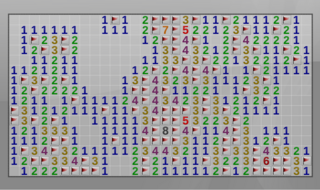
Minesweeper is a logic puzzle video game genre generally played on personal computers. The game features a grid of clickable squares, with hidden "mines" scattered throughout the board. The objective is to clear the board without detonating any mines, with help from clues about the number of neighboring mines in each field. Variants of Minesweeper have been made that expand on the basic concepts, such as Minesweeper X, Crossmines, and Minehunt. Minesweeper has been incorporated as a minigame in other games, such as RuneScape and Minecraft's April Fools Update.
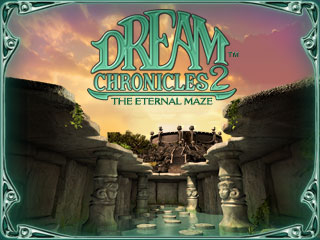
Dream Chronicles 2: The Eternal Maze is a 2008 adventure, hidden object, and puzzle casual game developed by KatGames and originally published by PlayFirst. It is the first sequel to 2007's award-winning game Dream Chronicles, also the second installment in the Dream Chronicles series, plus the middle part of the first trilogy called Faye's Journey.
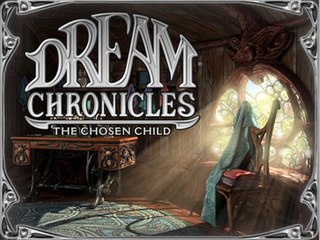
Dream Chronicles: The Chosen Child is a 2009 adventure and puzzle casual game developed by KatGames and originally published by PlayFirst. It is the third installment in the Dream Chronicles series, the second sequel to 2007's award-winning game Dream Chronicles and also the last part of the first trilogy called Faye's Journey.

Microsoft Ultimate Word Games is a word puzzle game published by Microsoft Studios, first released for Windows Phone as 'Wordament' on April 24, 2012. The game was relaunched in June 2017 with two new game modes, Crosswords and Word Twister.

Indiana Jones in the Lost Kingdom is a puzzle video game developed by Michael J. Hanson and published by Mindscape for the Commodore 64. The game is based on the Indiana Jones series, and was released in North America around January 1985, while a UK version was released in March 1985.


















